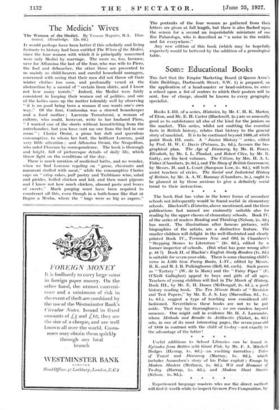The Medicis' Wives
The Women of the Medici. By Yvonne Maguire, M.A. Illus- trated. (Routledge. 12s. 6d.).
IT would perhaps have been better if this scholarly and living footnote to history had been entitled The Wives of the Medici, since the four women with which it is principally concerned were only Medici by marriage. The more so, too, because, save for Alfonsina the last of the four, who was wife to Piero, the fool and debauchee, the other three are presented to us mainly as child-bearers and careful household managers, concerned with seeing that their men did not throw off their winter clothes too soon, and- profoundly vexed at the abstraction by a menial of " certain linen shirts, and I know not how many towels." Indeed, the Medici were fairly consistent in keeping their women out of politics, and one of the ladies sums up the matter tolerably well by observing " it is no good being born a woman if one wants one's own way." Of the four, Contessina was a shrewd housekeeper and a fond mother ; Lucrezia Tornabuoni, a woman of culture, who could, however, write. to her husband Piero, " I wanted one of the sheets without hemstitching from the antechamber, but you have sent me one from the bed in our room " ; Clarice Orsini, a pious but dull - and querulous consumptive, to whom her lord, the brilliant Lorenzo, paid very little attention ; and Alfonsina Orsini, the Neapolitan, who ruled Florence by correspondence. The book is thorough and bright, full of picturesque details of daily life, which throw light on the conditions of the day.
. There is much mention of medicinal baths, and no wonder, when we find Lorenzo regaling on " geese, chestnuts and macaroni stuffed with meat," while the consumptive Clarice sups on " crisp cakes, puff pastry and Trebbiano wine, salad and pickles, boiled chicken and kid, and then roast pigeons and I know not how much chicken, almond paste and boxes of sweets." Much purging must have been required to counteract all this, even though in a bath-house like that at Bagno a Morba, where the " bugs were as big as capers."
The portraits of the four women as gathered from their letters are given at full, length, but tirere is also flashed upon the screen for a second an imperishable miniature of one Zoe Palaeologa, who is described as " a noise in the middle and fat everywhere."
Any new edition of this book (which may be hopefully expected) would be bettered by the addition of a genealogical table.














































 Previous page
Previous page